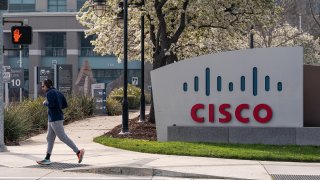
(This article was sent first to members of the CNBC Investing Club with Jim Cramer. To get the real-time updates in your inbox, subscribe here.)
Cisco Systems reported mixed fiscal first-quarter results after the closing bell Wednesday. Revenue increased 8% YoY to $12.9 billion and missed estimates of $12.984 billion, while adjusted earnings per share grew 8% YoY to $0.82 and exceeded estimates by one penny.
Adjusted total gross margins look okay to us at 64.5%, down from 65.8% last year but slightly better than estimates of 64.1%. Cisco is currently experiencing pressure on its cost structure for a number of supply chain related reasons. Higher input and commodity costs are a factor as well. Although Cisco has prudently increased prices to offset these headwinds, the benefit is not immediate, and it will be recognized over the coming quarters.
We can break down Cisco's total revenue into two categories: Product and Service. Product revenue increased about 11% YoY to $9.529 billion, barely missing estimates of $9.538 billion. Meanwhile, Services revenue was roughly flat YoY at $3.371 billion, short of the $3.442 billion estimate.
Get top local stories in Philly delivered to you every morning. >Sign up for NBC Philadelphia's News Headlines newsletter.
Cisco breaks down its product revenue into five main buckets: Secure Agile Networks, Hybrid Work, End-to-End Security, Internet for the future, and Optimized Applications Experience.
- Secure Agile Networks revenue increased 10% YoY to $5.967 billion thanks to a double digit increase in campus switching, which is led by Cisco's Catalyst 9000 and Meraki switching offerings. The enterprise routing portfolio performed well too, growing in the high single digit range. Wireless was up double digits thanks to their WiFi 6 products and Meraki wireless offerings.
- Hybrid Work revenue fell 7% YoY to $1.109 billion. Revenues fell due to declines in Cisco's perpetual calling, meetings, and contact center offerings. But not all parts of the business fell as the ramp of communication platform as a service and growth in collaboration devices offset some of the declines. Importantly, Cisco's SaaS revenue (software as a subscription) grew in the high single digits.
- End-to-End Security revenue grew 4% YoY to $895 million as growth in cloud-based solutions was offset by the decline in their perpetual and hardware offerings. The subscription part of security did well in the quarter, with revenues increasing 15%, driven by cloud security and Zero Trust platforms.
- Internet for the future revenue climbed 46% YoY to $1.374 billion thanks in large part to the strength of their web scale customers.
- Optimized Applications Experience revenue increased 18% YoY to $181 million, driven by triple digit growth in ThousandEyes and strong double digit growth in Intersight.
- With the quarter constrained by challenges in the supply chain, we think a better way to understand how the business is performing is through order growth. Think of order growth as a measure of Cisco's backlog. Total product orders in the quarter increased 33% YoY, representing the third straight quarter of accelerating order growth and off an even tougher comparison. Cisco is seeing the demand come in all over the place. Every geographic region had orders up by over 30% YoY and three of the four customer markets had order growth above 30%, too.
Total software revenue in the quarter was $3.7 billion as growth slowed due to the company's transformation from selling perpetual license to selling more as a subscription.
- Of the $3.7 billion in software revenue, 80% was sold as a subscription. This figure is down from 81% in the prior quarter. ARR, or annual recurring revenue, increased 10% YoY to $21.6 billion.
- Cisco's remaining performance obligation, or RPO, ended the quarter at $30.1 billion, which is down from $30.9 billion in the prior quarter but still up 10% YoY. 53% of the total RPO is short term, meaning this is revenue the company expects to recognize this revenue in the next twelve months.
- Total Software, subscription revenue, ARR, and the RPO are all big focuses of investors because these metrics help investors gauge the progress of the company's business transition from lumpy hardware sales to higher margin, more predictable software sales. Broadly speaking, we consider this business model transition as a price-to-earnings multiple expansion opportunity because investors tend to put more value on companies that have stable earnings growth and can expand margins.
Cisco returned $1.8 billion to shareholders through dividends and buybacks. However, the rate of buybacks noticeably slowed down. After buying back $791 million worth of stock in the previous quarter at an average price of $53.30 per share, Cisco only repurchased $256 million worth of stock in the reported quarter at an average price of $56.49. Management currently has $7.7 billion remaining on its current authorization.
Money Report
Disappointing Guidance: Management's guidance Wednesday evening left investors wanting more as all that momentum in order growth has yet to show up to the top line due to the supply chain. For the fiscal second quarter, Cisco expects revenues to grow 4.5% to 6.5% YoY, implying total revenue between $12.50 billion and $12.74 billion which is well below the $12.835 billion the street had modeled. In explanation of the disconnect between guidance and the street, CFO Richard Herren said on the call that the component supply issues are putting a headwind on "what can get pushed out the door." Adjusted gross margins are expected to be in the range of 63.5% to 64.5%. Cisco also anticipates adjusted earnings per share in the range of $0.80 to $0.82, which at the $0.81 is light of the $0.82 consensus estimate.
Management left their full-year outlook unchanged despite the underwhelming second-quarter guide. The company expects revenue growth of 5% to 7% YoY and adjusted earnings per share in the range of $3.38 to $3.45. The fact that the full-year outlook remains on plan suggests that the company is expecting to have a stronger second half of the year than what the market anticipated.
It's also important to remember that this year was the very first time management even offered an annual outlook. This is all new for Cisco and management was able to give investors the forecast because its subscription and recurring revenue streams were finally large enough to offer predictability for the full company. Management is conservative to begin with, so we can't be completely surprised that management left its full-year numbers alone so early into the year.
Overall, we are disappointed by the quarter and how the stock is trading after-hours. How can we not be? Although some of the issues in the supply chain are out of the company's control, we think it's also important to take a step back and remember that Cisco plays into the right markets and trends. Hybrid work is driving the recovery in enterprise spending, and the company is seeing a ton of business from 5G, digital transformations, security, and the cloud. The momentum in these trends has made the demand for Cisco's products and services as strong as it's ever been.
The order book is there, and the backlog has never been higher in the company's history. They are winning new business and even recently got a new customer with Meta (formerly Facebook) on the Silicon One architecture.
The issue right now is that the company is very constrained in what it can make and deliver to its customers. These challenges won't last forever, so the question we must ask ourselves is how long are we willing to wait this out? We are inclined to stick with Cisco on the belief that the maximum pain in the supply chain will be done in the next quarter, followed by slight improvements in the second half of the fiscal year.
The CNBC Investing Club is now the official home to my Charitable Trust. It's the place where you can see every move we make for the portfolio and get my market insight before anyone else. The Charitable Trust and my writings are no longer affiliated with Action Alerts Plus in any way.
As a subscriber to the CNBC Investing Club with Jim Cramer, you will receive a trade alert before Jim makes a trade. Typically, Jim waits 45 minutes after sending a trade alert before buying or selling a stock in his charitable trust's portfolio. If the trade alert is sent pre-market, Jim waits 5 minutes after the market opens before executing the trade. If the trade alert is issued with less than 45 minutes in the trading day, Jim executes the trade 5 minutes before the market closes. If Jim has talked about a stock on CNBC TV, he waits 72 hours after issuing the trade alert before executing the trade. See here for the investing disclaimer.
(Jim Cramer's Charitable Trust is long CSCO, FB.)






